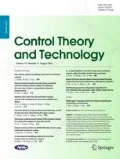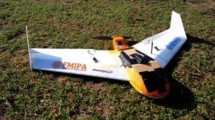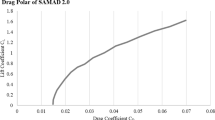Abstract
This paper presents a system identification method to derive accurate mathematical models for an unmanned circulation control aerial vehicle (UC2AV) that account for the effects of circulation control (CC) on the vehicle dynamics. The X-plane flight simulator and the CIFER system identification software are utilized to first derive simulation models to verify and validate the proposed system identification methodology. This is followed by flight tests to derive mathematical models and stability derivatives for the aircraft with CC-on and CC-off. Flight tests indicate a nose down pitching moment effect induced by CC, which in turn alter the UAV trim values and dynamics. Analysis of the two sets of mathematical models reveal that CC changes the longitudinal trim values and improves the lateral maneuverability of the UAV. Verification experiments indicate an acceptable match between the derived models and UAV dynamics by calculating root mean square (RMS) error values and by quantifying the model predictive ability through calculating the Theil inequality coefficient (TIC).
Similar content being viewed by others
References
K. Kanistras, S. P. Chander, K. P. Valavanis, et al. UC2AV unmanned circulation control aerial vehicle for short takeoff and enhanced payload. Proceedings of the 34th Applied Aerodynamics Conference, Washington DC: AIAA, 2016.
W. E. Milholen, G. S. Jones, D. T. Chan, et al. Enhancements to the FAST-MAC circulation control model and recent high-reynolds number testing in the national transonic facility. Proceedings of the 31st AIAA Applied Aerodynamics Conference, San Diego: AIAA, 2013: 1–25.
S. Carnduff. System Identification of Unmanned Aerial Vehicles. Ph.D. dissertation. Cranfield University: Cranfield University, 2008.
Y. L. H. Chao, L. Di, Y. Chen. Roll channel fractional order controller design for a small fixed-wing unmanned aerial vehicle. Control Engineering Practice, 2010, 18(7): 761–772.
A. Buonanno, M. V. Cook. Flight dynamics simulation of a flapless flight control UAV. Proceedings of the 25th International Congress of the Aeronautical Sciences, Hamburg, German, 2006: 3244–3254.
J. Dongwon, T. Panagiotis. Modeling and hardware-in-the loop simulation for a small unmanned aerial vehicle. AIAA Infotech@Aerospace Conference and Exhibit, California: AIAA, 2007: DOI https://doi.org/10.2514/6.2007-2768.
A. Dorobantu, A. M. Muruch, B. Mettler, et al. Frequency domain system identification for a small, low-cost, fixed-wing UAV. AIAA Guidance, Navigation and Control Conference, Portland: AIAA, 2011: DOI https://doi.org/10.2514/6.2011-6719.
N. V. Hoffer, C. Coopmans, A. M. Jensen. A survey and categorization of small low-cost unmanned aerial vehicle system identification. Journal Intelligent & Robotic Systems, 2014, 74(1-2): 129–145.
W. Debusk, G. Chowdhary, E. Johnson. Real time system identification of a small multi-engine aircraft. AIAA Atmospheric Flight Mechanics Conference, Chicago: AIAA, 2009: DOI https://doi.org/10.2514/6.2009-5935.
J. Evans, G. Elkaim, B. Parkinson. System identification of an autonomous aircraft using GPS. Proceedings of the 10th International Technical Meeting of the Satellite Division of the Institute of Navigation, Kansas City, 1997: 1065–1071.
G. S. Jones, W. E. Milholen, D. T. Chan, et al. Development of the circulation control flow scheme used in the NTF semi-span FAST-MAC model. Proceedings of the 31st AIAA Applied Aerodynamics Conference, San Diego: AIAA, 2013: DOI https://doi.org/10.2514/6.2013-3048.
K. Kanistras, M. J. Rutherford, N. Vitzilaios, et al. Experimental study of circulation control wings at low Reynolds numbers. 33nd AIAA Applied Aerodynamics Conference, Atlanta: AIAA, 2014: DOI https://doi.org/10.2514/6.2014-2307.
K. Kanistras, P. C. Chander, K. P. Valavanis, et al. Low speed wing tunnel investigation of a circulation control wing for enhanced lift. 33rd AIAA Applied Aerodynamics Conference, Dallas: AIAA, 2015: DOI https://doi.org/10.2514/6.2015-2575.
K. Kanistras, S. P Chander, K. P. Valavanis, et al. Development of a Framework for a Circulation Control-Based Unmanned Aerial Vehicle IEEE Aerospace Conference, Big Sky: IEEE, 2014: DOI https://doi.org/10.1109/AERO.2016.7500881.
K. Kanistras, M. J. Rutherford, K. P. Valavanis. Development of a circulation control wing for UAVs. IEEE Aerospace Conference, Big Sky: IEEE, 2014: DOI https://doi.org/10.1109/AERO.2014.6836386.
S. P. Chander. Design and Development of an Air Supply System for an Unmanned Circulation Control Aerial Vehicle. M.Sc. thesis. Denver: University of Denver, 2016.
B. Etkin, L. D. Reid. Dynamics of Flight Stability and Control. New York: Wiley, 1996.
T. M. Foster, W. J. Bowman. Dynamic stability and handling qualities of small unmanned-aerial vehicles. Proceedings of the 43rd AIAA Aerospace Sciences Meeting and Exhibit, Reno, Nevada: AIAA, 2005: DOI https://doi.org/10.2514/6.2005-1023.
M. Agha. System Identification of a Circulation Control Unmanned Aerial Vehicle. M.Sc. thesis. Denver: University of Denver, 2017.
M. B. Tischler, R. K. Remple. Aircraft and Rotorcraft System Identification: Engineering Methods with Flight Test Examples. Herndon: AIAA, 2006.
A. Bittar, H. Figuereido, A. Mendes. Guidance software in the loop simulation using X-plane and Simulink for UAVs. Internation Conference on Unmanned Aircraft Systems, Orlando: IEEE, 2014: DOI https://doi.org/10.1109/ICUAS.2014.6842350.
J. W. Hager, J. F. Behensky, B. W. Drew. The universal grids: universal transverse mercator (UTM) and universal polar sterographic (UPS). DMA Technical Manual, Washington, D.C.: Defense Mapping Agency Hydrographic/Topographic Center, 1989.
M. Agha, K. Kanistras, P. C. Saka, et al. System identification of circulation control UAV using X-plane flight simulation software and flight data. AIAA Modeling and Simulation Technologies Conference, Denver: AIAA, 2017: DOI https://doi.org/10.2514/6.2017-3154.
Author information
Authors and Affiliations
Corresponding author
Additional information
This research was partially supported by the National Science Foundation (No. CMMI/DCSD-1728454).
Mohammed AGHA received an M.Sc. degree in Mechatronics Systems Engineering and a B.Sc. in Electrical Engineering from the University of Denver. His research interests are system identification and simulation testing methods of unmanned vehicles. His research focus has been determining the affects of circulation control on the dynamics of UAVs.
Konstantinos KANISTRAS is an Assistant Professor at the Mechanical and Aerospace Department at the University of Alabama in Huntsville. His research focuses on aircraft performance and active flow control. His work looks to develop a fundamental understanding of the physics of the flow, the underlying flow structures and more effectively apply flow control techniques. Dr. Kanistras received his Ph.D. degree in Electrical and Computer Engineering from the University of Denver in 2016. He received his M.Sc. degree in Aerospace Engineering from the University of Bath, U.K. in 2008 and his B.Sc. degree in Physics from the University of Patras, Greece. He is an AIAA member since 2012.
Matthew J. RUTHERFORD is an Associate Professor in the Department of Computer Science with a joint appointment in the Department of Electrical and Computer Engineering. He is also Deputy Director of the DU Unmanned Systems Research Institute (DU2SRI). His research portfolio includes: the development of advanced controls and communication mechanisms for autonomous aerial and ground robots; applications of real-time computer vision to robotics problems using GPU-based parallel processing; testing and dynamic evaluation of embedded, real-time systems; development of complex mechatronic systems (mechanical, electrical, and software); the development of software techniques to reduce the amount of energy being consumed by hardware; and development of a high-precision propulsion system for underwater robots.
Kimon P. VALAVANIS is a Professor, Department of Electrical and Computer Engineering, with a joint appointment in the Department of Computer Science. He is also Director of the DU Unmanned Systems Research Institute (DU2SRI). He holds a Guest Professor appointment in the Department of Telecommunications, Faculty of Electrical Engineering and Computing at the University of Zagreb, Croatia. His research interests span the areas of intelligent control, robotics and automation, and distributed intelligent systems, focusing on: integrated control and diagnostics of unmanned systems; modeling and formation control of cooperative robot teams; navigation/control of unmanned aerial vehicles; modeling, design and development of complex mechatronic systems; and design of the next generation of unmanned systems; mathematical theories for intelligent machines. He is Fellow of the American Association for the Advancement of Science (AAAS), Senior Member of IEEE, Editor-in-Chief of the Journal of Intelligent and Robotic Systems (Springer), and Fulbright Scholar.
Rights and permissions
About this article
Cite this article
Agha, M., Kanistras, K., Rutherford, M.J. et al. Mathematical model derivation of an unmanned circulation control aerial vehicle UC2AV. Control Theory Technol. 18, 1–18 (2020). https://doi.org/10.1007/s11768-020-8151-4
Received:
Revised:
Accepted:
Published:
Issue Date:
DOI: https://doi.org/10.1007/s11768-020-8151-4




